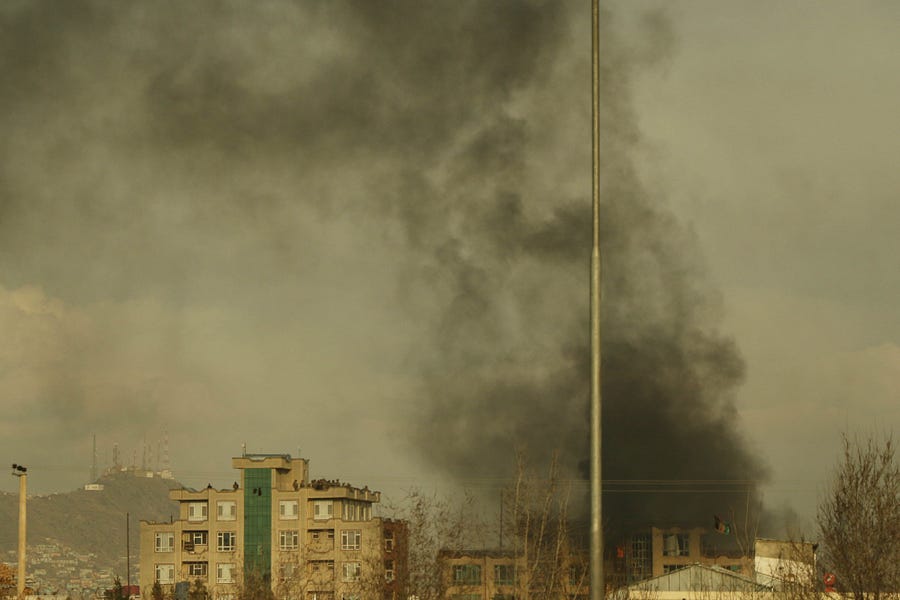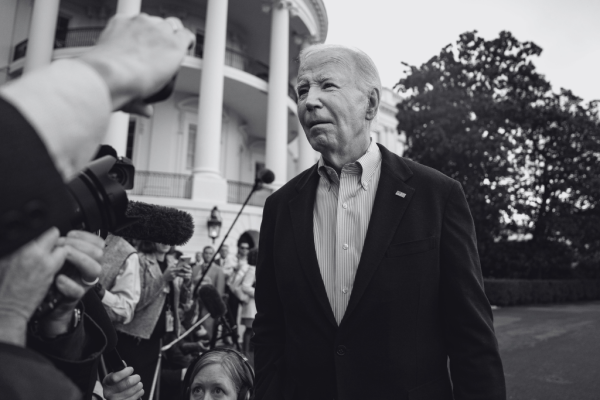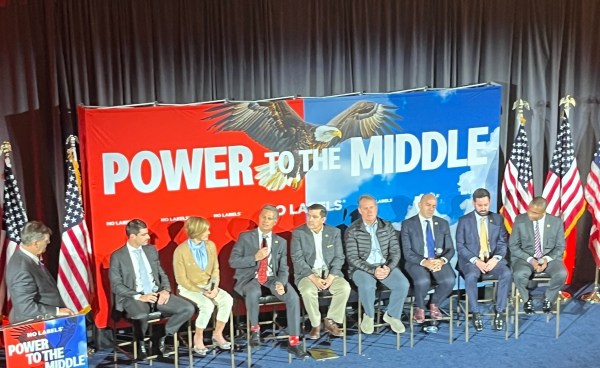On Tuesday, a pair of monstrous terrorist attacks reminded the world that the war in Afghanistan rages on. In the Afghan capital of Kabul, gunmen stormed a bustling hospital operated by Doctors Without Borders. The jihadists killed at least two dozen people, including newborn babies and mothers in a nursery. Elsewhere, in the eastern Afghan province of Nangarhar, a suicide bomber detonated himself at a funeral for a local police official. More than two dozen people were killed and numerous others wounded. The Islamic State’s Khorasan province (ISIS-K) quickly claimed responsibility for the latter bombing in Nangarhar. No party immediately accepted fault for the Kabul maternity ward shooting, though it is widely suspected that ISIS-K is behind that attack as well.
The Taliban denied culpability for both attacks. Secretary of State Mike Pompeo and U.S. Special Representative for Afghanistan Reconciliation Zalmay Khalilzad quickly seized upon the Taliban’s denial, portraying the group as a possible counterterrorism partner.
“We note the Taliban have denied any responsibility and condemned both attacks as heinous,” Pompeo said in a statement. “The Taliban and the Afghan government should cooperate to bring the perpetrators to justice.” Khalilzad tweeted the same, claiming the Taliban and Afghan government should cooperate “against a common enemy that perpetrates” such barbarism.
Pompeo and Khalilzad are the main architects of the U.S.-Taliban withdrawal agreement, which was finalized on February 29 in Doha. The deal that was supposed to pave the way for a peace process has been a spectacular failure. There is no hint of peace more than two months after it was signed.
Why? The short answer: The Taliban doesn’t want peace.
This hasn’t stopped Pompeo and Khalilzad from adopting a view of the Taliban that is entirely inconsistent with reality. They ignore the fact that the Taliban, not ISIS-K, is the main actor driving violence throughout the country. While the attacks in Kabul and Nangarhar are indeed “heinous,” the Taliban’s actions are no less so. The Taliban, and not ISIS-K, still terrorizes more civilians than any other party in Afghanistan. And while Pompeo and Khalilzad have argued that the Taliban can be America’s de facto counterterrorism partner, there is no reason to think that is true. There is no evidence indicating that the Taliban has broken with al-Qaeda, despite the supposed counterterrorism assurances enshrined in the February 29 accord.
The Taliban went on the offensive immediately after the deal was signed.
The U.S., the Afghan government and other nations have repeatedly pleaded with the Taliban to temporarily lay down its arms in anticipation of peace talks. But the Taliban has consistently rejected calls for a ceasefire. The jihadists agreed only to a short-lived “reduction in violence” during the days leading up to the signing of the Doha accord. The ink wasn’t even dry on that deal when the group unleashed a fury of attacks on Afghan forces throughout the country, killing and wounding hundreds of people. This campaign began in early March and continues to this day.
The United Nations Assistance Mission in Afghanistan (UNAMA) has documented the Taliban’s post-deal offensive. In late April, UNAMA warned that there was a “disturbing increase in violence” after the signing in Doha. The principal culprit is the Taliban. The number of civilian casualties during the first quarter of 2020 was lower than in previous years, but it was still high, with 710 people either killed (282) or wounded (428). And the dip in late February did not lead to a lasting reprieve. UNAMA attributes more than half of Afghan civilian deaths and injuries to the “anti-government elements,” meaning the Taliban and its allies, as well as ISIS-K. UNAMA found that the Taliban caused 39 percent of civilian casualties during the first quarter of the year. By comparison, attacks by ISIS-K accounted for 13 percent of civilian deaths and injuries.
That is, while the attacks in Kabul and Nangarhar have grabbed much attention, the Taliban’s own pervasive violence is far more costly for civilians. Each and every week, more innocent men, women, and children are killed and maimed by the Taliban than any other actor in the war.
The Taliban’s men are also busy hollowing out the Afghan security forces and picking off its opponents throughout the country. Since February 29, the Taliban has claimed responsibility for hundreds of operations across nearly every Afghan province. And the group is likely behind many more.
Earlier this month, Reuters reported that two separate data sets (one maintained by a “Western military source” and the other by an “independent body”) show that the Taliban has carried out “more than 4,500 attacks in Afghanistan, marking a sharp escalation in violence, in the 45 days since signing a deal with the United States.”
That is more than 100 Taliban attacks per day. While many of these were small-scale operations, the pace and scope of the Taliban’s insurgency are still far more problematic than anything ISIS-K can muster. On May 10, for instance, the Taliban overran an Afghan National Army outpost in the eastern province of Laghman, killing more than two dozen Afghan soldiers. This type of raid is more advanced than the massacres ISIS-K conducts. It requires advanced planning, training, and weaponry. Although ISIS-K remains lethal, it doesn’t have the capacity to carry out attacks on the same level throughout the country. Only the Taliban and its al-Qaeda-affiliated allies do.
The U.S. military is certainly aware that the Taliban is driving the war, as American officials have pleaded with the group to reduce violence. The Taliban objects to such pleas, correctly noting that it made no such commitment in the February 29 agreement. “But we spoke of ALL sides reducing violence by as much as 80% to pave the way for peace talks,” U.S. Forces-Afghanistan spokesman Col. Sonny Leggett wrote in a May 2 response to the Taliban.
“Spoke”—not wrote. If the Taliban had truly committed to reducing violence after February 29, it would have been in writing. It isn’t.
The reality of the Taliban’s ongoing war has come crashing down on the Afghan government, which was not a party to the bilateral U.S.-Taliban agreement. Afghan President Ashraf Ghani announced on Tuesday that security forces were going on the “offensive” against the Taliban and other jihadists. The Afghans had been in something called “active defense” mode—patiently waiting for the Taliban to make some genuine gesture toward peace. But the Taliban continued to reject both the U.S. military’s calls for a reduction in violence and Ghani’s ceasefire offers.
Al-Qaeda lauds the U.S.-Taliban withdrawal agreement.
Without any progress toward peace on the ground, Pompeo and Khalilzad have trumpeted the Taliban’s supposed counterterrorism assurances as a diplomatic success. This has always been their No. 1 selling point for the deal. In exchange for an American withdrawal, the Taliban’s political delegation agreed that the group would prevent al-Qaeda or other anti-American terrorists from using Afghan soil to plan international attacks. There are many problems with the Taliban’s counterterrorism promises, as detailed previously in Vital Interests. For starters, the Taliban has lied about the terrorist threat to the West and its close relationship with al-Qaeda since the 1990s. There are no verification or enforcement mechanisms spelled out in the Doha agreement to ensure the Taliban isn’t lying now.
In his public appearances after the deal was signed, Pompeo went well beyond the written text. He even claimed that the Taliban has agreed to help America “destroy” al-Qaeda in Afghanistan.
More than two months have passed since the Doha accord was signed. While the Taliban has reportedly carried out thousands of attacks on Afghan forces and its other local foes during that time, it hasn’t conducted a single operation against al-Qaeda or affiliated groups in Afghanistan. Not a single one.
The Taliban has many jihadist targets to choose from, ranging from Al-Qaeda in the Indian Subcontinent’s (AQIS) men to smaller ethnic jihadist groups that are clearly part of al-Qaeda’s international web. These al-Qaeda actors are embedded within the Taliban insurgency, fighting to overthrow the Afghan government and resurrect the Taliban’s Islamic Emirate of Afghanistan in its place. The Taliban hasn’t turned on any of them.
Nor has the Taliban renounced al-Qaeda. The Taliban’s propagandists publish daily messages in Arabic, Dari, English, Pashto and Urdu. They are prolific. Yet not one of these statements since February 29 has mentioned al-Qaeda, let alone renounced it. Al-Qaeda’s global leader, Ayman al-Zawahiri, has sworn his allegiance to Haibatullah Akhundzada, the top emir of the Taliban. Akhundzada hasn’t said a word about Zawahiri or al-Qaeda. Sirajuddin Haqqani, Akhundzada’s top deputy, runs a Taliban subgroup that has been intertwined with al-Qaeda since the 1980s. Haqqani hasn’t said or written a word about al-Qaeda since February 29. It would be easy for the Taliban to release a statement, in multiple languages, denouncing al-Qaeda. The group hasn’t done so. That’s telling.
It is no wonder that al-Qaeda’s senior leadership endorsed the U.S.-Taliban withdrawal agreement. In a three-page statement released online in March, al-Qaeda lauded the Taliban’s “historic victory” over the U.S. and congratulated Akhundzada as the “Emir of the Faithful,” a title usually reserved for a Muslim caliph. Al-Qaeda called on Muslims around the globe to support the Taliban’s Islamic Emirate, arguing that all jihadists should emulate the group, because of its success against the Americans. Al-Qaeda’s senior management team also instructed all of their followers to abide by the terms of the Doha accord. It is impossible to square such guidance with Pompeo’s claim that the Taliban is going to finally turn on its blood brothers.
In its statement praising the withdrawal deal, al-Qaeda also lauded Mullah Omar for standing firm after 9/11, when the Taliban founder defended Osama bin Laden and his men against the might of America. “Allah has promised us victory, and Bush has promised us defeat. The world will see which of these promises will be fulfilled,” Omar vowed. Al-Qaeda has repeatedly these cited words, which look more and more prophetic with each passing day.
The Taliban continues to revel in Omar’s defiance as well. In a written eulogy posted on the seventh anniversary of Omar’s death in late April, the Taliban claimed that Omar’s obstinance in late 2001 and thereafter is what “brought down another idol of this age,” meaning America. At no point in the eulogy did the Taliban express remorse for, or disapproval of Omar’s decision to stand by bin Laden.
Taliban apologists in the West have tried to rewrite history, claiming that Omar and his organization were never really that close to al-Qaeda. A mountain of evidencecontradicts their obfuscation. But there is an obvious problem with the claims made by the Taliban’s most ardent defenders. If the two are really wholly separate, then why, after all these years, does the Taliban still refuse to denounce al-Qaeda? The same type of question can be asked of Secretary Pompeo. If al-Qaeda is really a “shadow of its former self,” as Pompeo claims, then shouldn’t the Taliban find it easy to publicly and unequivocally renounce its relationship with Zawahiri’s organization?
Pompeo and Khalilzad portray their agreement as a diplomatic triumph, claiming the Taliban has finally agreed to “break” with al-Qaeda. But if al-Qaeda is already a spent force, as Pompeo insists against much evidence, then that wouldn’t be much of a concession, now would it? (And again, the Taliban has not actually agreed to renounce, “break” or “destroy” al-Qaeda.)
Pompeo more critical of Afghan government than the Taliban.
With the coronavirus pandemic taking hold in late March, Secretary Pompeo traveled halfway around the world to Afghanistan. Nearly a month had passed since the agreement at that point, but his deal with the Taliban hadn’t led to any real steps toward peace. Pompeo blamed the Afghan government.
The secretary of state first met with President Ghani and former Chief Executive Abdullah Abdullah. The two political rivals were at an impasse, bickering over how the Afghan government would be structured. The Afghans also dragged their feet on a prisoner exchange with the Taliban. Pompeo and Khalilzad promised that the Afghan government would release up to 5,000 jihadists in exchange for up to 1,000 prisoners held by the Taliban. Ghani and his administration weren’t allowed to take part in State Department’s talks with the Taliban. But Pompeo and Khalilzad agreed to this concession—an uneven swap—in exchange for the Taliban merely attending “intra-Afghan” talks.
Ghani and Abdullah didn’t settle their differences during Pompeo’s visit to Kabul. And Pompeo bristled in a statement issued immediately afterward on March 23. Pompeo wrote that the U.S. was “disappointed” in Ghani and Abdullah, claiming their “leadership failure poses a direct threat to U.S. national interests.” Pompeo announced that the U.S. was “immediately reducing assistance” to the Afghan government “by $1 billion this year” and is “prepared to reduce by another $1 billion in 2021.” The political talks between Ghani and Abdullah resumed in the days that followed, while the Afghan government began slowly releasing Taliban prisoners.
Pompeo met with Mullah Baradar, a senior Taliban political official in Doha, immediately after his trip to Kabul. Judging by Pompeo’s description, his meeting with Baradar wasn’t nearly as acrimonious as his sit down with Ghani and Abdullah. During a press briefing that followed, Pompeo denied that he had harsh words for the Afghan government, even though he clearly did. Pompeo praised the Taliban’s actions since the agreement was signed, claiming the group had “committed to reducing violence” and “they have largely done that.”
That is simply not true. As the U.N., press reporting and the Taliban’s own claims make clear, the jihadists went on a rampage following the February 29 agreement.
It’s true that the Taliban hasn’t directly attacked American forces. But why would they? The U.S. is withdrawing its forces, which has been the Taliban’s central goal all along. Why would the Taliban do anything to forestall America’s retreat? For the most part, the Taliban has also refrained from headline-grabbing operations inside Afghanistan’s cities, such as the one this week in Kabul, but that doesn’t mean the jihadists have reduced violence. All of the reporting says exactly the opposite is the case.
There is no indication in the State Department’s transcripts or statements that Pompeo pressed the Taliban on its relationship with al-Qaeda. Did Pompeo demand that Baradar orchestrate a formal Taliban renunciation of al-Qaeda? Did he insist that the Taliban turn over AQIS leaders or fighters, or at least divulge their locations to the U.S.? Did he ask Baradar why al-Qaeda’s senior leadership thinks the U.S.-Taliban withdrawal agreement is a “victory” for the jihadists, and not a blow to their agenda?
If Pompeo addressed any of these concerns, then it is a well-kept secret.
We are left with a situation in which Pompeo believes that the political squabbling in Kabul is “a direct threat to U.S. national interests,” but apparently the Taliban’s unbroken, decades-long alliance with al-Qaeda is not. The Afghan government deserves much criticism, but it isn’t the Taliban. There was a time when this basic distinction would have seemed obvious.
All President Trump wants is to withdraw American forces from Afghanistan. None of this is necessary to accomplish a full withdrawal, or close to it. It isn’t necessary to absolve the Taliban on the way out the door.
Photograph of a March 2020 attack on Kabul by STR/AFP via Getty Images.





Please note that we at The Dispatch hold ourselves, our work, and our commenters to a higher standard than other places on the internet. We welcome comments that foster genuine debate or discussion—including comments critical of us or our work—but responses that include ad hominem attacks on fellow Dispatch members or are intended to stoke fear and anger may be moderated.
You are currently using a limited time guest pass and do not have access to commenting. Consider subscribing to join the conversation.
With your membership, you only have the ability to comment on The Morning Dispatch articles. Consider upgrading to join the conversation everywhere.